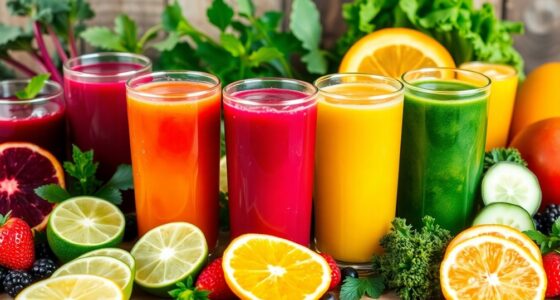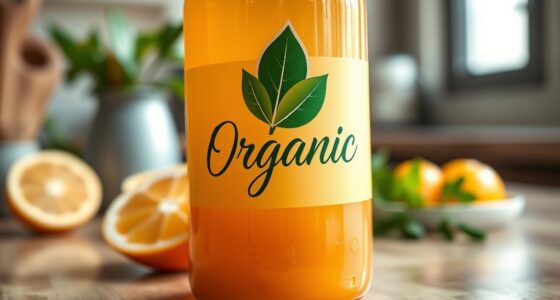When buying organic citrus, you should know that peel residues, though less common, can still occur due to environmental factors or supply chain contamination. Properly washing your fruit with cold water and gentle scrubbing helps reduce any pesticide residues on the surface. Peeling can offer extra protection but also removes nutrients and flavor. To guarantee safety and quality, choosing transparent sources and handling the fruit carefully is key. Continue exploring for more tips on maintaining organic citrus freshness and safety.
Key Takeaways
- Proper washing with cold water and gentle scrubbing reduces pesticide residues on organic citrus peels.
- Peeling citrus can remove surface residues but also eliminates nutrients and flavor.
- Residues may still be present on organic citrus due to environmental factors and supply chain contamination.
- Sourcing from transparent, trusted suppliers ensures better adherence to organic standards and safer produce.
- Combining thorough washing and careful handling minimizes chemical residue risks on organic citrus fruits.

Have you ever wondered where your organic citrus fruits come from? It’s a valid question, especially when you’re trying to guarantee that what you’re eating stays true to its organic label. One of the main concerns with citrus fruits, even those labeled organic, is the potential presence of pesticide residues. While organic farming standards limit synthetic pesticide use, some farms might still use natural pesticides or face contamination through environmental factors. That’s why supply chain transparency becomes essential. Knowing the journey your citrus takes from farm to table helps you verify that strict organic practices are maintained throughout the process. When producers and distributors are open about their sourcing and handling, it eases your worries about pesticide residues lingering on your fruit. Transparency means you can trust that the oranges, lemons, or limes you buy aren’t just labeled organic but are also genuinely handled with care and integrity.
Once your organic citrus reaches the store or market, proper washing becomes your next line of defense. Pesticide residues, even in small amounts, can cling to the fruit’s surface, which is why thorough washing is vital. You might think a quick rinse is enough, but it’s better to take your time. Using cold water and gently scrubbing the peel can considerably reduce any residues that might still be present. Some people opt for a vinegar solution or a commercial fruit wash, but plain water with a scrub brush often does the trick for most residues. Remember, citrus peels are porous, so residues can sometimes seep into the skin, making washing even more important. If you’re especially cautious, peeling the citrus can eliminate residues altogether, but this also removes some of the fruit’s beneficial nutrients and flavor.
Understanding the importance of peeling and washing highlights how vital it is to handle your organic citrus with care. It’s not just about the label but about actively reducing any potential chemical residues that might have made their way onto your fruit. While organic standards aim to minimize such risks, they can’t entirely eliminate them, which is why your actions matter. Being mindful of supply chain transparency allows you to choose fruits from trusted sources, and proper washing ensures those fruits are as safe as possible when you enjoy them. Incorporating holistic approaches and best practices in handling your citrus can further enhance your safety and enjoyment. In the end, taking these simple steps helps you savor your organic citrus with peace of mind, knowing you’re doing your part to reduce exposure and support sustainable, transparent farming practices.
Frequently Asked Questions
Are Organic Citrus Peels Safe for Human Consumption?
Yes, organic citrus peels are safe for human consumption, but you should be aware of peel residue and potential safety concerns. Organic farming minimizes pesticide use, reducing harmful chemicals, yet residues can still remain. Always wash the peels thoroughly to remove dirt and residues. Consuming organic citrus peels provides nutrients and antioxidants, but guarantee proper washing to minimize safety concerns and enjoy their health benefits safely.
How Can Consumers Identify Organic Citrus From Non-Organic?
You can identify organic citrus by looking for the USDA Organic label or other trusted certifications on the packaging. These indicate the fruit meets strict organic standards, including limited pesticide residues. Trust certified labels over non-organic options, and inspect the fruit for natural appearance without synthetic waxes or coatings. This helps guarantee you’re choosing citrus that’s grown with fewer chemicals and adheres to organic practices.
Do Organic Citrus Washing Methods Differ From Conventional?
You might think organic citrus gets a fancy spa treatment, but actually, washing techniques are quite similar to conventional methods. Organic certification emphasizes avoiding synthetic chemicals, but both types often undergo rinsing to remove dirt and residues. So, while you’d hope organic citrus gets extra care, in reality, the main difference lies in the certification standards, not the washing process itself. Be vigilant, and trust the label!
What Environmental Impacts Are Associated With Citrus Washing?
When you wash citrus, environmental impacts mainly involve water pollution and pesticide runoff. Using large amounts of water can lead to runoff carrying pesticides and residues into nearby water sources, harming ecosystems. To minimize this, opt for eco-friendly washing methods, like using biodegradable solutions or reducing water use. By doing so, you help protect water quality and reduce the negative effects of pesticide runoff on the environment.
Are There Natural Alternatives to Chemical Washes for Organic Citrus?
Yes, there are natural washes you can use instead of chemical ones for organic citrus. You might consider using a solution of water and vinegar or baking soda, which effectively cleans peel residues without harmful chemicals. These natural washes help remove dirt and residues while maintaining the fruit’s organic integrity. Always rinse thoroughly afterward to guarantee all residues are removed, supporting eco-friendly practices and safe consumption.
Conclusion
By choosing organic citrus, you’re supporting sustainable farming and reducing waste from peel residues and washing processes. Every step you take makes a difference in protecting the environment and promoting healthier choices. Isn’t it time you contemplated how your citrus sourcing impacts the planet? Making mindful decisions today helps ensure a better tomorrow—so why not start with your next citrus purchase and embrace truly organic practices?









